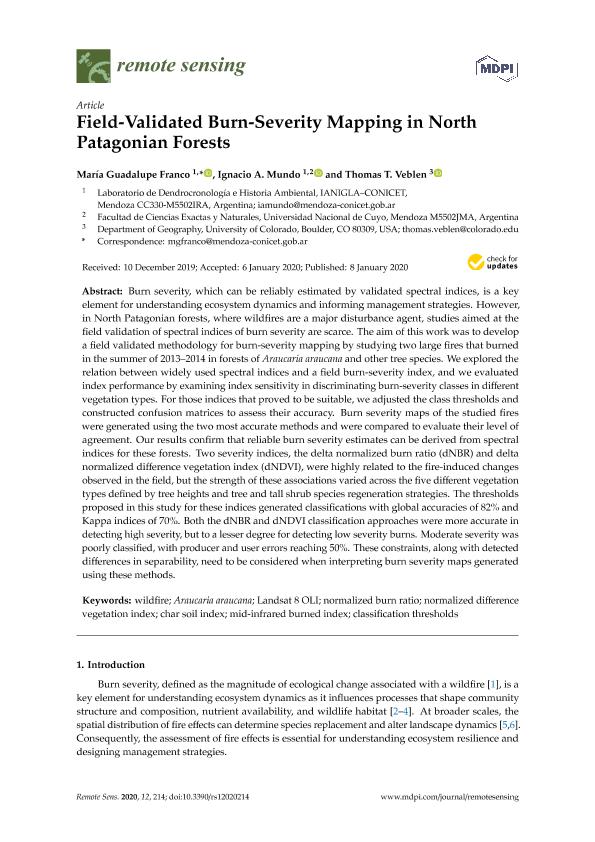Artículo
Field-validated burn-severity mapping in North Patagonian forests
Fecha de publicación:
01/2020
Editorial:
Molecular Diversity Preservation International
Revista:
Remote Sensing
ISSN:
2072-4292
Idioma:
Inglés
Tipo de recurso:
Artículo publicado
Clasificación temática:
Resumen
Burn severity, which can be reliably estimated by validated spectral indices, is a key element for understanding ecosystem dynamics and informing management strategies. However, in North Patagonian forests, where wildfires are a major disturbance agent, studies aimed at the field validation of spectral indices of burn severity are scarce. The aim of this work was to develop a field validated methodology for burn-severity mapping by studying two large fires that burned in the summer of 2013-2014 in forests of Araucaria araucana and other tree species. We explored the relation between widely used spectral indices and a field burn-severity index, and we evaluated index performance by examining index sensitivity in discriminating burn-severity classes in different vegetation types. For those indices that proved to be suitable, we adjusted the class thresholds and constructed confusion matrices to assess their accuracy. Burn severity maps of the studied fires were generated using the two most accurate methods and were compared to evaluate their level of agreement. Our results confirm that reliable burn severity estimates can be derived from spectral indices for these forests. Two severity indices, the delta normalized burn ratio (dNBR) and delta normalized difference vegetation index (dNDVI), were highly related to the fire-induced changes observed in the field, but the strength of these associations varied across the five different vegetation types defined by tree heights and tree and tall shrub species regeneration strategies. The thresholds proposed in this study for these indices generated classifications with global accuracies of 82% and Kappa indices of 70%. Both the dNBR and dNDVI classification approaches were more accurate in detecting high severity, but to a lesser degree for detecting low severity burns. Moderate severity was poorly classified, with producer and user errors reaching 50%. These constraints, along with detected differences in separability, need to be considered when interpreting burn severity maps generated using these methods.
Archivos asociados
Licencia
Identificadores
Colecciones
Articulos(IANIGLA)
Articulos de INST. ARG. DE NIVOLOGIA, GLACIOLOGIA Y CS. AMBIENT
Articulos de INST. ARG. DE NIVOLOGIA, GLACIOLOGIA Y CS. AMBIENT
Citación
Franco, María Guadalupe; Mundo, Ignacio Alberto; Veblen, Thomas T.; Field-validated burn-severity mapping in North Patagonian forests; Molecular Diversity Preservation International; Remote Sensing; 12; 2; 1-2020; 1-18
Compartir
Altmétricas




